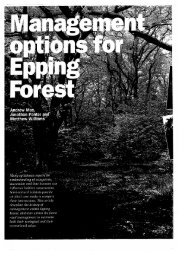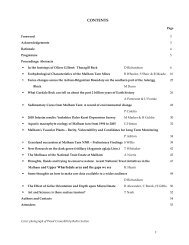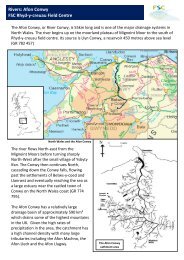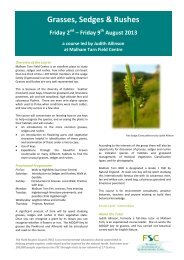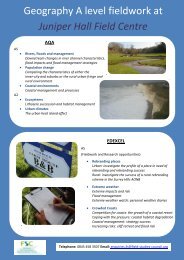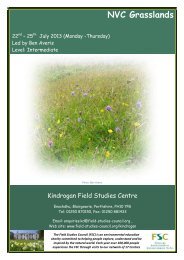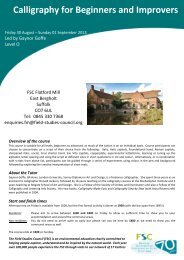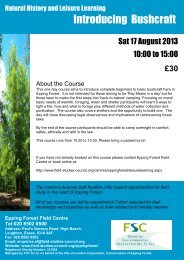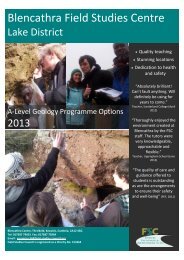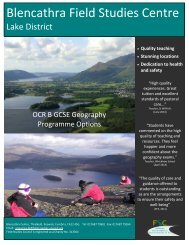A review of research on outdoor learning - Field Studies Council
A review of research on outdoor learning - Field Studies Council
A review of research on outdoor learning - Field Studies Council
- No tags were found...
Create successful ePaper yourself
Turn your PDF publications into a flip-book with our unique Google optimized e-Paper software.
The specific aims <str<strong>on</strong>g>of</str<strong>on</strong>g> the project were:• to establish what is known (and not known) about:> young people’s experiences <str<strong>on</strong>g>of</str<strong>on</strong>g> <strong>outdoor</strong> <strong>learning</strong>> the impact <str<strong>on</strong>g>of</str<strong>on</strong>g> <strong>outdoor</strong> <strong>learning</strong> activities <strong>on</strong>young people> factors that can impede or facilitate youngpeople’s <strong>learning</strong> in the <strong>outdoor</strong>s> factors that can impede or facilitate the provisi<strong>on</strong><str<strong>on</strong>g>of</str<strong>on</strong>g> <strong>outdoor</strong> <strong>learning</strong>• to identify the implicati<strong>on</strong>s <str<strong>on</strong>g>of</str<strong>on</strong>g> the <str<strong>on</strong>g>research</str<strong>on</strong>g> for futurepractice, policy and <str<strong>on</strong>g>research</str<strong>on</strong>g> in <strong>outdoor</strong> <strong>learning</strong>.More details about how these aims were addressedare provided in Chapters 2 and 3. Before this, though,it is important to c<strong>on</strong>sider the historical developmentand c<strong>on</strong>temporary policy c<strong>on</strong>text <str<strong>on</strong>g>of</str<strong>on</strong>g> <strong>outdoor</strong> <strong>learning</strong>in this country.1.3 Historical development<str<strong>on</strong>g>of</str<strong>on</strong>g> <strong>outdoor</strong> <strong>learning</strong>Outdoor educati<strong>on</strong> has a l<strong>on</strong>g and rich history in theUK, within which there is a diversity <str<strong>on</strong>g>of</str<strong>on</strong>g> views aboutwhat <strong>outdoor</strong> educati<strong>on</strong> c<strong>on</strong>stitutes and who it shouldinvolve. This historical overview seeks to highlightsome key traditi<strong>on</strong>s that have influenced the culture<str<strong>on</strong>g>of</str<strong>on</strong>g> <strong>outdoor</strong> educati<strong>on</strong> provisi<strong>on</strong> in the UK.The nature study movementA major milest<strong>on</strong>e in the early history <str<strong>on</strong>g>of</str<strong>on</strong>g> <strong>outdoor</strong>educati<strong>on</strong> was the impact <strong>on</strong> teaching <str<strong>on</strong>g>of</str<strong>on</strong>g> the naturestudy movement in the classrooms <str<strong>on</strong>g>of</str<strong>on</strong>g> Victorian andEdwardian England. This was not an isolated activity,in that much <str<strong>on</strong>g>of</str<strong>on</strong>g> society at the time held a fascinati<strong>on</strong>for flora and fauna, both domestic and exotic (see, forexample, Baratay and Hardouin-Fugier, 2002). Ofinterest, particularly in the c<strong>on</strong>text <str<strong>on</strong>g>of</str<strong>on</strong>g> this <str<strong>on</strong>g>review</str<strong>on</strong>g>, wasthe role <str<strong>on</strong>g>of</str<strong>on</strong>g> HMI in this movement. Inspectors such asJ.G. Rooper wrote extensively in magazines such asTeacher’s Aid <strong>on</strong> the importance <str<strong>on</strong>g>of</str<strong>on</strong>g> utilising livingspecimens in their habitats rather than specimens thatwere, ‘dried and ticketed in a museum’ (Rooper, 1894,p. 530). During this period, the study <str<strong>on</strong>g>of</str<strong>on</strong>g> botany inparticular was c<strong>on</strong>sidered to be <strong>on</strong>e <str<strong>on</strong>g>of</str<strong>on</strong>g> the fewscientific and <strong>outdoor</strong> educati<strong>on</strong>al activitiesappropriate for women (Shteir, 1996), and it is againstthis cultural background that botanical educators,such as Dr Lilian Clarke teaching at a south L<strong>on</strong>d<strong>on</strong>girls’ school, developed innovative teaching practicesin the design and use <str<strong>on</strong>g>of</str<strong>on</strong>g> school gardens.Clarke taught at the school from 1896 to 1926 and was<strong>on</strong>e <str<strong>on</strong>g>of</str<strong>on</strong>g> the first six women to be elected a Fellow <str<strong>on</strong>g>of</str<strong>on</strong>g> theLinnaean Society <str<strong>on</strong>g>of</str<strong>on</strong>g> L<strong>on</strong>d<strong>on</strong>. Her legacy forc<strong>on</strong>temporary <strong>outdoor</strong> educati<strong>on</strong>/field studies was to:• promulgate the use <str<strong>on</strong>g>of</str<strong>on</strong>g> the ‘<strong>outdoor</strong> classroom’• have a proactive view <str<strong>on</strong>g>of</str<strong>on</strong>g> learner’s creating theirown textbooks from ‘hands-<strong>on</strong>’ work in the garden• recognise that teachers and learners c<strong>on</strong>tribute tothe pace <str<strong>on</strong>g>of</str<strong>on</strong>g> the less<strong>on</strong>• document her teaching to share with others (seeClarke, 1922, 1935)• form partnerships with external agencies andinstituti<strong>on</strong>s.School journeysThe Nature Study Movement and botanical pursuitswere not the <strong>on</strong>ly influences <strong>on</strong> <strong>outdoor</strong> educati<strong>on</strong>. Inthe late nineteenth century, Catherine Dodd iscredited with adopting the c<strong>on</strong>cept <str<strong>on</strong>g>of</str<strong>on</strong>g> the schooljourney from Germany (Jenkins, 1980; Cook, 2001), anidea that greatly enlarged the range <str<strong>on</strong>g>of</str<strong>on</strong>g> envir<strong>on</strong>mentsthat children could experience. Dodd herself usedexcursi<strong>on</strong>s into rural Derbyshire for ‘observati<strong>on</strong> anddiscussi<strong>on</strong> <strong>on</strong> geographical, historical, biological andaesthetic topics’ (Cook, 2001, p. 44). In 1911 the SchoolJourney Associati<strong>on</strong> was formed and, according toJenkins (1980, p. 61), ‘flourished until the Great War’.School journeys have become an integral part <str<strong>on</strong>g>of</str<strong>on</strong>g> thelives <str<strong>on</strong>g>of</str<strong>on</strong>g> many schoolchildren today.<strong>Field</strong> studiesThe recent 60 th Anniversary Celebrati<strong>on</strong> C<strong>on</strong>ference <str<strong>on</strong>g>of</str<strong>on</strong>g>the <strong>Field</strong> <strong>Studies</strong> <strong>Council</strong> (FSC) highlighted the rolethat field studies has played in the development <str<strong>on</strong>g>of</str<strong>on</strong>g><strong>outdoor</strong> <strong>learning</strong> in this country. The establishment <str<strong>on</strong>g>of</str<strong>on</strong>g>the <strong>Council</strong> for the Promoti<strong>on</strong> <str<strong>on</strong>g>of</str<strong>on</strong>g> <strong>Field</strong> <strong>Studies</strong> (theforerunner to the FSC) in 1943 initiated a network <str<strong>on</strong>g>of</str<strong>on</strong>g>10 >>> A <str<strong>on</strong>g>review</str<strong>on</strong>g> <str<strong>on</strong>g>of</str<strong>on</strong>g> <str<strong>on</strong>g>research</str<strong>on</strong>g> <strong>on</strong> <strong>outdoor</strong> <strong>learning</strong>



